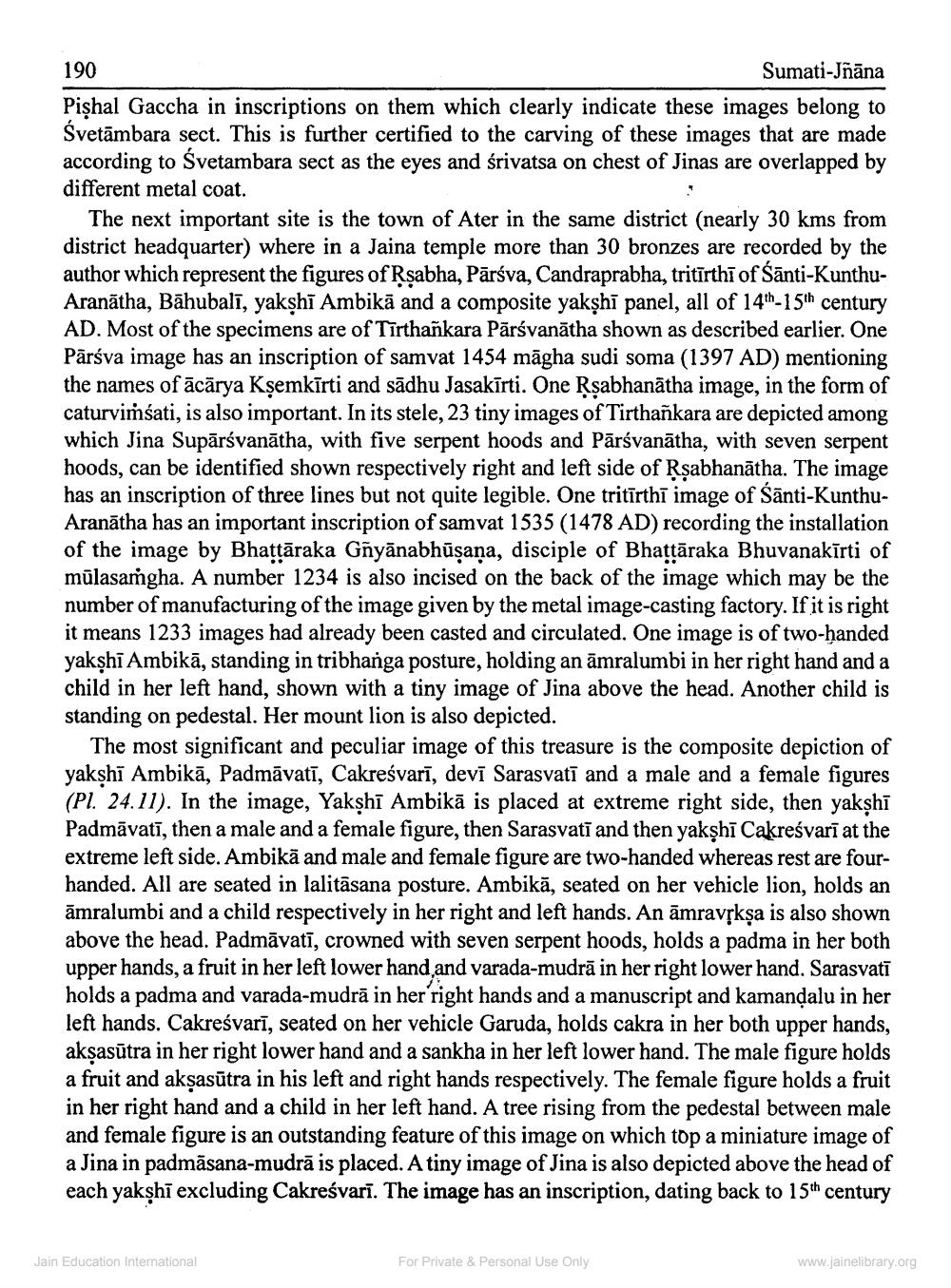________________
190
Sumati-Jñāna
Pişhal Gaccha in inscriptions on them which clearly indicate these images belong to Śvetambara sect. This is further certified to the carving of these images that are made according to Śvetambara sect as the eyes and śrivatsa on chest of Jinas are overlapped by different metal coat.
The next important site is the town of Ater in the same district (nearly 30 kms from district headquarter) where in a Jaina temple more than 30 bronzes are recorded by the author which represent the figures of Rṣabha, Pārsva, Candraprabha, tritīrthī of Śānti-KunthuAranātha, Bahubalī, yakṣhī Ambikā and a composite yakṣhi panel, all of 14th-15th century AD. Most of the specimens are of Tirthankara Pārśvanatha shown as described earlier. One Pārśva image has an inscription of samvat 1454 magha sudi soma (1397 AD) mentioning the names of ācārya Kṣemkīrti and sādhu Jasakīrti. One Ṛṣabhanatha image, in the form of caturviṁśati, is also important. In its stele, 23 tiny images of Tirthankara are depicted among which Jina Supārśvanatha, with five serpent hoods and Pārsvanatha, with seven serpent hoods, can be identified shown respectively right and left side of Rṣabhanatha. The image has an inscription of three lines but not quite legible. One tritīrthī image of Santi-KunthuAranatha has an important inscription of samvat 1535 (1478 AD) recording the installation of the image by Bhaṭṭāraka Gñyānabhūṣaṇa, disciple of Bhaṭṭāraka Bhuvanakīrti of mūlasaṁgha. A number 1234 is also incised on the back of the image which may be the number of manufacturing of the image given by the metal image-casting factory. If it is right it means 1233 images had already been casted and circulated. One image is of two-handed yakshi Ambikā, standing in tribhanga posture, holding an amralumbi in her right hand and a child in her left hand, shown with a tiny image of Jina above the head. Another child is standing on pedestal. Her mount lion is also depicted.
The most significant and peculiar image of this treasure is the composite depiction of yakṣhī Ambikā, Padmāvatī, Cakreśvarī, devī Sarasvatī and a male and a female figures (Pl. 24.11). In the image, Yakshi Ambikā is placed at extreme right side, then yakṣhī Padmavati, then a male and a female figure, then Sarasvati and then yakṣhi Cakreśvarī at the extreme left side. Ambika and male and female figure are two-handed whereas rest are fourhanded. All are seated in lalitasana posture. Ambika, seated on her vehicle lion, holds an amralumbi and a child respectively in her right and left hands. An amravṛkṣa is also shown above the head. Padmavatī, crowned with seven serpent hoods, holds a padma in her both upper hands, a fruit in her left lower hand and varada-mudrā in her right lower hand. Sarasvati holds a padma and varada-mudra in her right hands and a manuscript and kamandalu in her left hands. Cakreśvarī, seated on her vehicle Garuda, holds cakra in her both upper hands, akṣasūtra in her right lower hand and a sankha in her left lower hand. The male figure holds a fruit and akṣasūtra in his left and right hands respectively. The female figure holds a fruit in her right hand and a child in her left hand. A tree rising from the pedestal between male and female figure is an outstanding feature of this image on which top a miniature image of a Jina in padmasana-mudrā is placed. A tiny image of Jina is also depicted above the head of each yakshi excluding Cakreśvarī. The image has an inscription, dating back to 15th century
Jain Education International
For Private & Personal Use Only
www.jainelibrary.org




